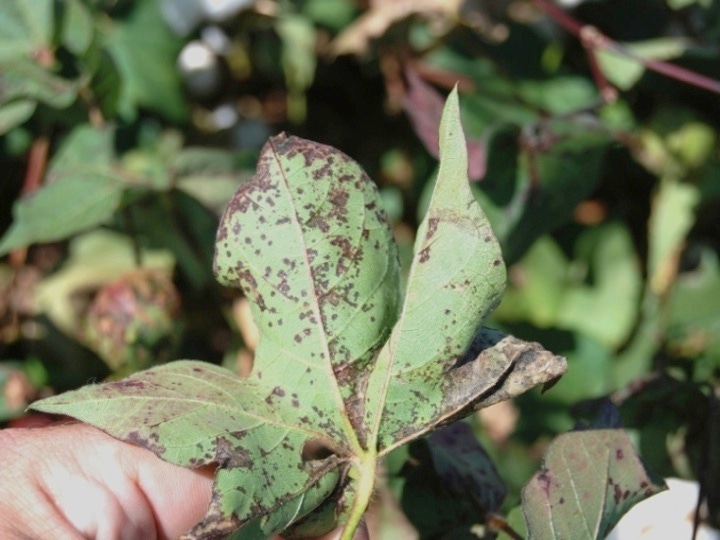October 15, 2015

The moderate temperatures and wet conditions experienced throughout the High Plains from May to July were conducive for the development of bacterial blight (Fig. 1). An increase in the disease was observed across most of the region with observations of bacterial blight-like symptoms occurring on varieties that had previously been documented as being resistant or immune.
Initial ratings of a research trial near Plains, Texas, found the disease to be present in most all plots with disease incidence averaging nearly 25 percent. Upon closer examination, the ratings were found to be incorrect resulting from erroneous labeling of plots in the field. This is good news from a production perspective, as the updated disease ratings with correctly labeled plots immune.
For the latest on southwest agriculture, please check out Southwest Farm Press Daily and receive the latest news right to your inbox.
It is interesting to note that bacterial blight symptoms have been and continue to be observed on partially resistant, resistant and immune varieties (Table 1); however, the incidence of these symptoms did not intensify compared to what was observed on susceptible varieties. We would like to apologize for the errant reporting of disease incidence ratings in early August; however, the fundamental question of “Why we are seeing bacterial blight symptoms on resistant or immune varieties?” remains.
Bacterial blight was also found on FiberMax 1830GLT in a trial near Amherst, and on FM 2484B2F from a field trial in Lubbock. We are continuing to examine the occurrence of disease and hope to better understand the factor(s) that have led to the development of bacterial blight on such varieties.
Currently, the implication of this aspect of the disease on yield is not known. Boll infections (Fig. 1) were less common than the foliar symptoms. It is likely that yield of resistant or immune varieties will not be affected; however, it will be important to document fields where bacterial blight was observed this year in order to monitor the disease in subsequent years.
We appreciate all who submitted samples for disease diagnosis.
Please contact Dr. Wheeler (806-746-6101; [email protected]) or Jason Woodward (806-632-0762; [email protected]) with any comments, questions or concerns you may have about bacterial blight in cotton.
Table 1
Table 1. Updated bacterial blight incidence ratings from a variety trial near Plains, TX exhibiting Bacterial blight on most all varieties throughout the seasonz
Variety or breeding line
Disease incidence (%)
Race 18 resistance rating
5-Aug
26-Aug
16-Sep
BX1531GLT
28
19
14
No data yet
BX1532GLT
20
35
21
No data yet
BX1633GLT
45
80
68
No data yet
BX1634GLT
21
58
53
No data yet
BX1635GLT
7
0
0
No data yet
BX1637GLT
3
1
0
No data yet
DP0912B2RF
16
59
45
Susceptible
DP1311B2RF
6
51
46
Susceptible
DP1321B2RF
70
100
100
Susceptible
DP1359B2RF
7
0
1
Partially resistant
DP1410B2RF
5
1
0
Resistant
DP1441RF
55
72
80
Susceptible
DP1454NRB2RF
93
100
100
Susceptible
DP1538B2RF
16
59
54
No data yet
DP1549B2RF
54
95
100
No data yet
DP1553B2RF
44
88
85
No data yet
DP1555B2RF
35
78
61
No data yet
DP1558NRB2RF
52
80
69
No data yet
FM1320GL
3
10
5
Susceptible
FM1830GLT
0
3
0
Immune
FM2007GLT
0
0
0
Resistant
FM2322GL
33
57
33
Susceptible
FM2334GLT
2
0
0
Immune
FM2484B2F
3
0
0
Immune
NG1511B2RF
26
58
44
Susceptible
NG5007B2RF
35
72
55
No data yet
PHX3003-WRF
19
29
8
No data yet
PHY339WRF
10
0
0
Partially resistant
PHY417WRF
50
75
28
Susceptible
PHY444WRF
15
5
15
No data yet
PHY487WRF
50
80
88
No data yet
PHY495W3RF
52
83
86
No data yet
PHY499WRF
34
51
66
Susceptible
PHY575WRF
0
0
1
No data yet
ST5289GLT
5
1
1
Immune
ST6182GLT
35
61
41
No data yet
MSD(0.05)
38
33
29
ZVarieties in bold represent those that have been designated as Partially resistant, Resistant or Immune from previous testing. Differences in disease incidence ratings between varieties within a column greater than the MSD are significantly different.
You May Also Like




